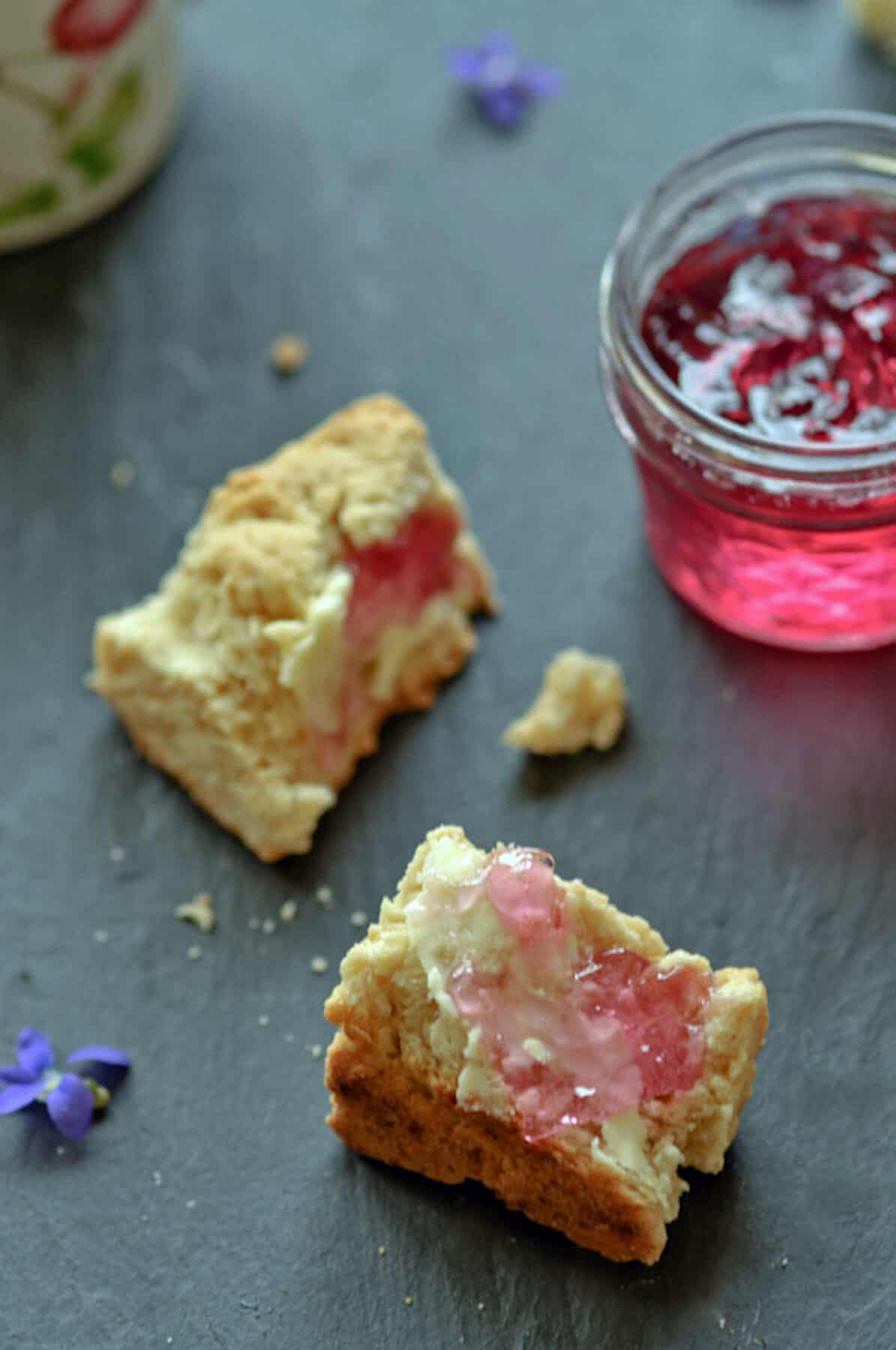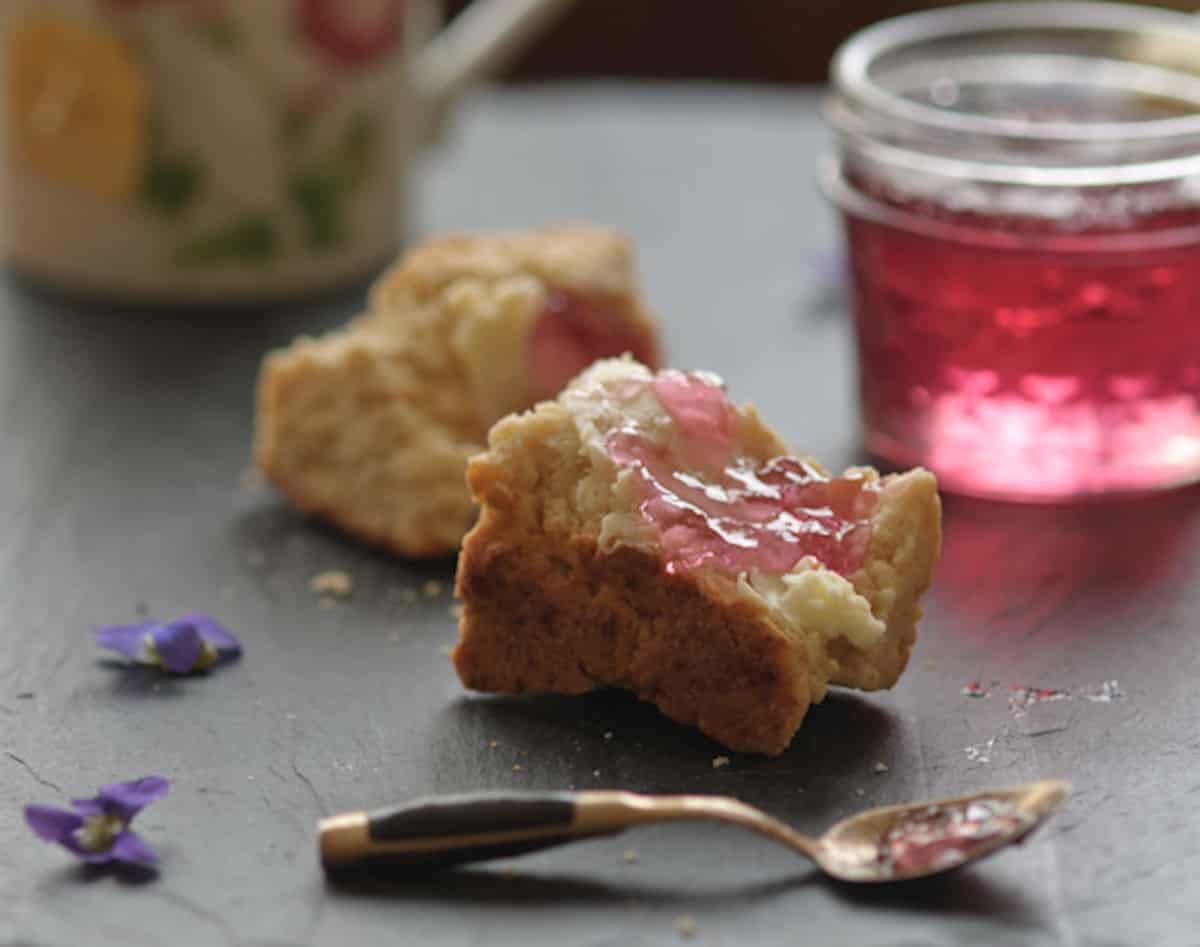Embrace the charm of spring with this Violet Jelly recipe, turning foraged wildflowers into a magenta-hued, subtly floral delight. Perfect for brightening your spring breakfast table.

Springtime offers a unique opportunity to forage for wild edibles, transforming them into delightful treats that capture the essence of the season. And I just go weak in the knees for recipes made with edible flowers. So when violets started popping up across my yard recently, I immediately set about gathering as many as possible.
I’ve had my eye on a violet syrup recipe in an old book called Healing Wise for years, but it calls for 1/2 pound of violets. If you’ve ever picked violets, you know they’re pretty much devoid of mass, so unless you’ve got a carpet of them underfoot (or an army of helpers), it takes a good while to collect even 1 cup. So I wanted to make something that did not require quite so many.

Last summer, I was obsessed with this rose petal and lemon balm jelly, so I did some googling to see if violet jelly was something I should be considering. The moment I started seeing photos of the vibrant amethyst-purple jelly, I was sold: I knew that my violets would meet a similar fate.
The violet jelly recipe that seems to be the “internet standard” has 4 cups of sugar, but I reduced it by half. The result is a jam with a perfectly sweet, subtly floral flavor that all but glows with an irresistible magenta hue; I could not help but bake up some fresh Greek yogurt biscuits to celebrate its beauty.
Why Bother with Violets?
According to herbalist Susun Weed, all violets (cultivated and wild) are edible: this even includes pansies (just make sure to only use violets that have not been sprayed with chemicals, and which are away from where your dogs do their business). In her book Healing Wise, Ms. Weed writes that violet leaves are very high in minerals and vitamin C, and can be used as food and as medicine (they are reputed to benefit many organs in the body and early herbal literature describes them as possessing anti-cancer properties). The flowers, which are featured in this recipe, also contain vitamin C and are believed to be beneficial to the sensory organs.

How to Make Violet Jelly
The process is very similar to making Redbud Jelly, and the first step is to make a tea with the violet blooms you’ve foraged.
1. Gather your violet flowers. Aim for open, fresh blooms. You’ll need about 2 cups of blooms. You’ll want to thoroughly de-stem your flowers by carefully pulling the green parts away from the flower. This can take some time but is key to capturing the floral flavor without introducing any added bitterness. This gathering and destemming process takes a little time, but it’s an enjoyable and meditative activity on a beautiful spring day.
2. Next, place the violet flowers in a heat-safe container or pot, and then pour 2 cups of boiling water over the flowers. Give it a stir and allow it to steep for about 4 hours, or until it cools, then transfer it to the refrigerator and allow it to rest overnight.
3. Use a fine-mesh strainer to strain the flowers out of the tea. Take some time to press the brewed blooms to extract as much liquid as possible. Your final tea might have a greenish tint to it at this point, and that’s fine.
4. Now that you have violet tea, you can proceed with making the violet jelly. Pour the tea into a medium saucepan and bring to a boil. Add 1/4 cup lemon juice and stir (the tea should turn purple!), then whisk in 1.75 ounces of pectin and 2 cups of sugar. Boil the mixture for about 5 minutes or until the jelly has just started to thicken.
5. Remove the pot from heat ladle the mixture into sterilized canning jars. Leave ¼ inch headspace at the top of each jar. Wipe the lips of the jars clean, place the lids on top, and secure with rings. If you’re going to eat the violet jelly within the next few weeks, you can just allow the jars to cool to room temperature and then put them in the refrigerator. Optionally, you can preserve your jars by water bath canning.

How to Store Violet Jelly
Jars that haven’t been preserved (or jars that were preserved that have been opened) should be stored in the fridge. As long as they remain cold, they will be good for up to 3 weeks.
If you preserved the jelly by water bath canning, take the rings off and check the seal. All jars that are sealed fully can be stored in the cupboard or pantry for up to one year.
More Fun with Violets
- Spinach and Violet Salad with Blue Cheese
- Spinach and Blood Orange Salad with Violets
- Candied Violets
Violet Jelly
Ingredients
- 2 cups violet flower petals no stems- make sure you gather them from an area which has not been sprayed with chemicals (and where your dogs don’t do their business)
- 2 cups water
- 1/4 cup lemon juice I used organic
- 1.75 oz pectin I used Mrs. Wages fruit pectin
- 2 cups sugar though I rarely use white sugar, I did in this case because I wanted to make sure the jelly would have the vibrant pink color
Instructions
- Rinse and drain flower petals, and place in heat-proof glass bowl. Bring water to a boil and pour over petals. Cover and allow to steep overnight, or for up to 24 hours.
- Strain the liquid through a fine mesh sieve: use a wooden spoon to press all the liquid from the plant material (compost or discard the flowers when you're through). The liquid will have a greenish tint at this point. If not using it right away, you can refrigerate it for up to 24 hours.
- Combine strained liquid with lemon juice in the saucepan (notice how it turns purple!), then whisk in the pectin and the sugar. Bring to a full rolling boil, whisking to ensure the sugar and pectin dissolve thoroughly, then turn heat to medium high and cook, stirring occasionally, for about 5 minutes (or until the jelly has reduced a bit and thickened).
- Skim off any foam and then ladle into your clean, hot and sterile jars, leaving 1/8″ head space. Wipe lids and screw on the the rings, then process in a hot-water bath for 10 minutes.
- Remove jars and allow to cool for 24 hours on the counter.








Fun recipe to make! The kids helped me pick the flowers. Tasted, to me, like a lemon jelly with a beautiful pink hue. I like lemon, so it was great. I even threw in a few fresh violets to each canning jar to make it even prettier.